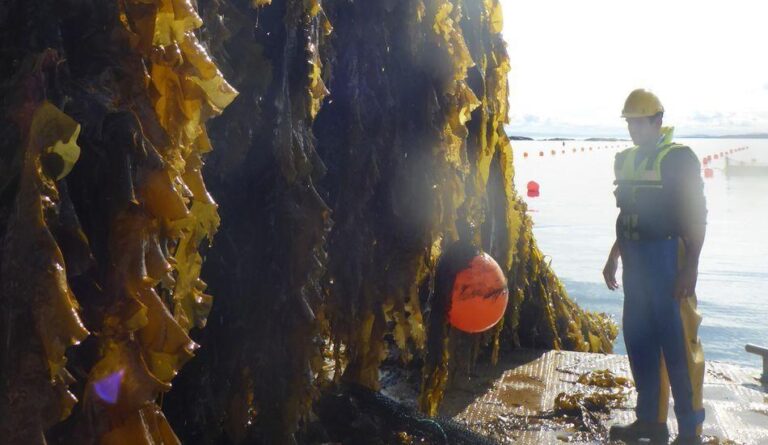Kelp grows super fast in modern sea farm
Bjørn L. Rønningen, Hitra-Frøya.no
"Biology shows that kelp grows super fast in modern sea farm. This year it will be about getting kelp safely out of the sea, into the online store and into your mouth."

"Here, just outside Sistranda, SES has the largest kelp cultivation license in Norway. The firm has invested long and seriously in seaweed farming, starting back in 2006. The company has been on the Frøya since 2011. Last year, SES began the pilot project which is partly financed by Innovation Norway (2014-2016), aiming to demonstrate cultivation on an industrial scale."
"- Experience from the first year of production is very good, says Kaia Kjølbo Rød in SES. She often gets questions from local people about what is 'going on out there.' "
"- Last year we measured 100 tons cultivated kelp in Taraskjæret, against under 10 tons the preceding year, and are confident that we have control over the biology and the farm for this major order, says Kjølbo Rød."
"- It grows very well. The plants that are released now after New Year is about 1 centimeter in size and will be harvested in May-June. Then the plants measure 1.5-2 meters. So the growth is enormous! Actually growing kelp faster than both sugar cane and rainforests. We have tested on a small scale for several years, and then it's really fun to see that it works when we test on a larger scale as well, she says."
"This year the goal is that SES will produce around 40 tonnes of seaweed, which is down in volume compared to last year. The reason is that in addition to further research on how to get the best possible yields in the sea, there will also be focus on what to do with the seaweed from when it is taken out of the water until it is used commercially in the market."
"- We work with the company Northern Company, who are selling algae for food online, and we hope to get our product in their online store. In addition we deliver to restaurants. There are in fact quite a lot of interest among Norwegian chefs to get this in restaurants. It is important that the product not only stays in the kitchen cupboard. We must also show how it can be used in practice, and then we think it's a good way to go via chefs. Then we can show Norwegians in a good way how seaweed can be used in food."
"Another project is to test the seaweed as an alternative source of feed for salmon aquaculture. SES is involved in several projects, including 'Foods of Norway' at the Norwegian University of Life Sciences at Ås, where kelp biomass is being tested as an alternative raw material for salmon feed."
"- This year we will try to freeze the biomass, which is ultimately to stop degradation, and then dry it. Because kelp is perishable. So we hope to get a finished product. We have not tried this out on a large scale before, so it will be exciting. Then it's very good to be here on Frøya, because we can work with what is already good local infrastructure. We are also faced with positivism and the belief that this could potentially be a major industry, she says."
(translated from the original article).
Original article (in Norwegian): http://www.hitra-froya.no/havbruk/2016/04/09/Taren-vokser-superraskt-i-det-moderne-fjøset-12574886.ece